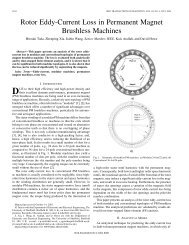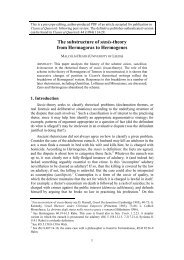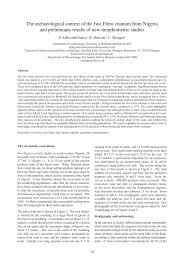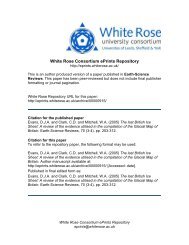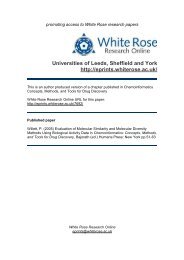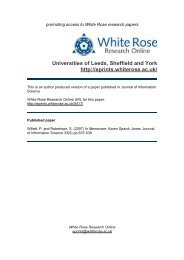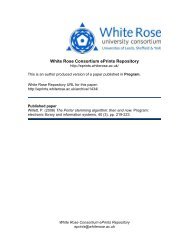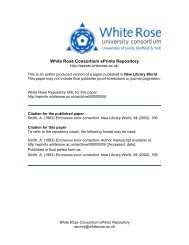The last British Ice Sheet: A review of the evidence utilised in the ...
The last British Ice Sheet: A review of the evidence utilised in the ...
The last British Ice Sheet: A review of the evidence utilised in the ...
Create successful ePaper yourself
Turn your PDF publications into a flip-book with our unique Google optimized e-Paper software.
<strong>of</strong> Evans and Rea (1999), strongly suggests that fast flow<strong>in</strong>g ice moved down <strong>the</strong> Loch Ryan bas<strong>in</strong> dur<strong>in</strong>g a<br />
surge. <strong>The</strong> earliest <strong>evidence</strong> <strong>of</strong> ice-marg<strong>in</strong>al deposition <strong>in</strong> southwest Scotland is provided by an ice-contact<br />
ground<strong>in</strong>g l<strong>in</strong>e fan/delta at 40 m OD on <strong>the</strong> south Machars (Salt, 2001). This feature was orig<strong>in</strong>ally<br />
<strong>in</strong>terpreted by Charlesworth (1926a) as part <strong>of</strong> his “kame mora<strong>in</strong>e” but has more recently been <strong>in</strong>terpreted as<br />
a delta formed <strong>in</strong> a glacilacustr<strong>in</strong>e depo-centre situated between Sou<strong>the</strong>rn Uplands and Solway/Lake District<br />
ice after <strong>the</strong>ir <strong>in</strong>itial uncoupl<strong>in</strong>g (Salt, 2001). Fur<strong>the</strong>r local <strong>evidence</strong> for such a lake is an extensive area <strong>of</strong><br />
large P-forms that disappear under till above approximately 40 m OD, <strong>the</strong>reby suggest<strong>in</strong>g that till has been<br />
widely removed below that altitude by wave-wash<strong>in</strong>g.<br />
A dense concentration <strong>of</strong> meltwater channels occurs <strong>in</strong> sou<strong>the</strong>ast Scotland and neighbour<strong>in</strong>g<br />
Northumberland, where many notable examples record flow around <strong>the</strong> eastern flank <strong>of</strong> <strong>the</strong> Cheviots and<br />
southward along <strong>the</strong> coastal pla<strong>in</strong> (Raistrick, 1931b; Clapperton, 1971a,b). Many <strong>of</strong> <strong>the</strong>se were orig<strong>in</strong>ally<br />
<strong>in</strong>terpreted as glacial lake overflow channels (Kendall and Muff, 1901, 1903) but have s<strong>in</strong>ce been expla<strong>in</strong>ed<br />
as primarily <strong>of</strong> subglacial orig<strong>in</strong> (Sissons, 1958a; Derbyshire, 1961; Clapperton, 1968). Classic examples<br />
<strong>in</strong>clude <strong>the</strong> Humbleton Hill and <strong>The</strong> Trows channels (Huddart, 2002b).<br />
Sand and gravel landforms around Coldstream were <strong>in</strong>terpreted by Charlesworth (1957) as mora<strong>in</strong>e ridges<br />
and used by Sissons (1967a) as part <strong>of</strong> his Aberdeen–Lammermuir Readvance. Carru<strong>the</strong>rs et al. (1930, 1932)<br />
had previously mapped an arcuate belt <strong>of</strong> sands and gravels east <strong>of</strong> <strong>the</strong> Cheviot massif and north <strong>of</strong> <strong>the</strong> River<br />
Aln, and suggested <strong>the</strong>y marked a possible marg<strong>in</strong> <strong>of</strong> <strong>the</strong> reced<strong>in</strong>g Tweed glacier. Included with<strong>in</strong> this kame<br />
belt was <strong>the</strong> Bradford Kaims or Bradford-Charlton Gravels which mark <strong>the</strong> nor<strong>the</strong>rn limit <strong>of</strong> a l<strong>in</strong>ear belt <strong>of</strong><br />
sand and gravel on <strong>the</strong> coastal pla<strong>in</strong> near Bamburgh. <strong>The</strong>re has been much debate <strong>in</strong> <strong>the</strong> literature as to <strong>the</strong><br />
orig<strong>in</strong> <strong>of</strong> <strong>the</strong>se landforms and <strong>the</strong>y are generally thought to be eskers associated with a northward retreat<strong>in</strong>g<br />
ice marg<strong>in</strong> (cf. Gregory, 1922; Parsons, 1966; Huddart, 2002c and references <strong>the</strong>re<strong>in</strong>). Also <strong>in</strong> <strong>the</strong> vic<strong>in</strong>ity is<br />
<strong>the</strong> “Cornhill kettle mora<strong>in</strong>e”, a large expanse <strong>of</strong> ice contact forms that cont<strong>in</strong>ue towards Wooler on <strong>the</strong><br />
marg<strong>in</strong> <strong>of</strong> <strong>the</strong> Cheviots (Douglas, 1991). <strong>The</strong> large accumulations <strong>of</strong> glacifluvial sediment <strong>in</strong> <strong>the</strong> River<br />
Aln/lower River Beamish/Wooler area document deglaciation <strong>of</strong> <strong>the</strong> eastern Cheviots (Clapperton, 1971a,b).<br />
As <strong>the</strong> Tweed ice stream downwasted and uncoupled from Tyne ice flow<strong>in</strong>g round <strong>the</strong> south <strong>of</strong> <strong>the</strong> Cheviot<br />
Massif glacial lakes occupied <strong>the</strong> lower River Beamish and River Aln. Meltwater channels, eskers, kame<br />
terraces, deltas and lam<strong>in</strong>ated lake sediments record <strong>the</strong> recession <strong>of</strong> <strong>the</strong> Tweed ice stream dur<strong>in</strong>g which<br />
ice-dammed lakes were temporarily ponded <strong>in</strong> <strong>the</strong> nor<strong>the</strong>rly dra<strong>in</strong><strong>in</strong>g valleys <strong>of</strong> <strong>the</strong> River Till and its<br />
tributaries. <strong>The</strong> <strong>last</strong> lake was at 45 m and occupied <strong>the</strong> Milfield bas<strong>in</strong>.<br />
20




